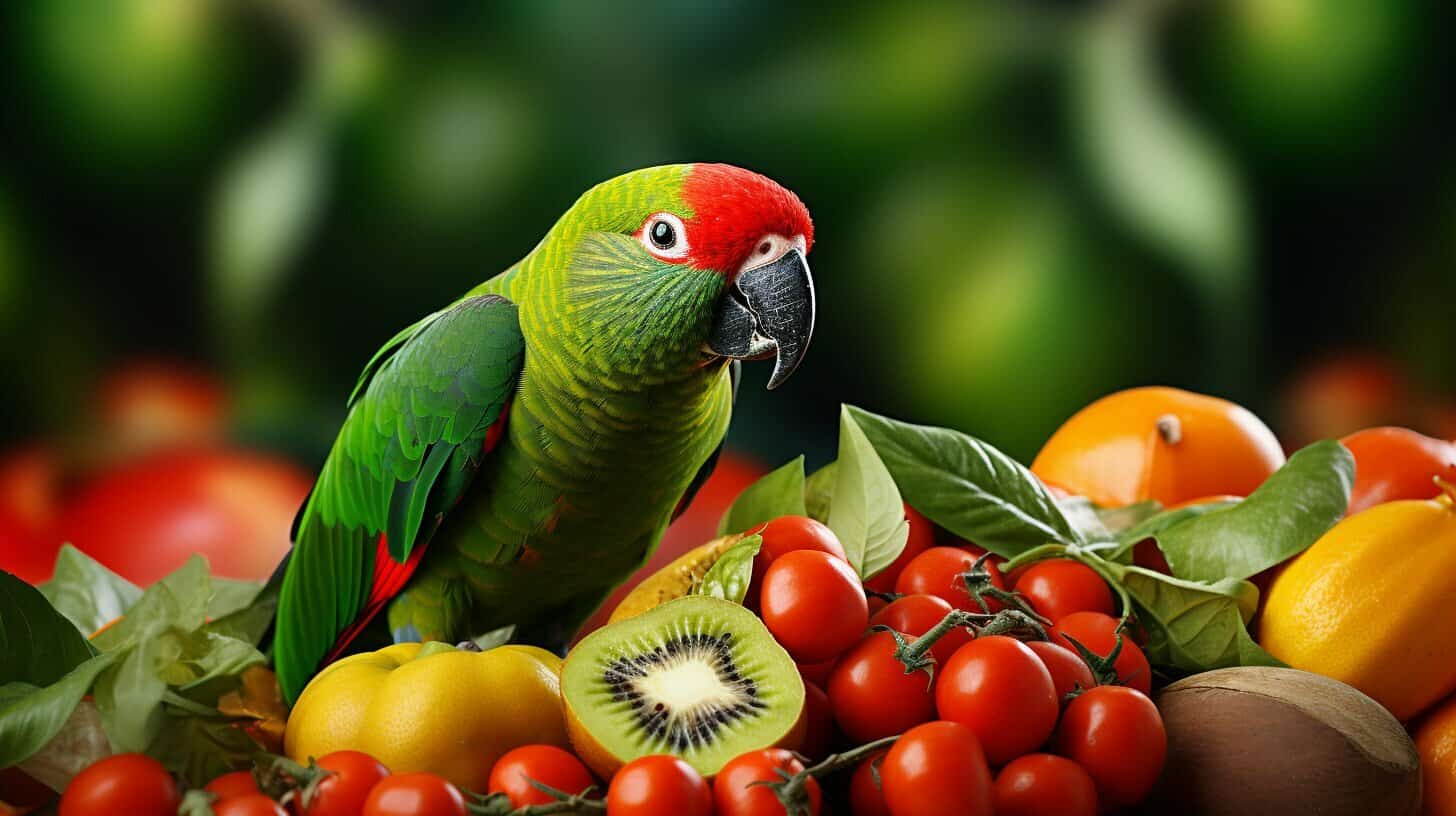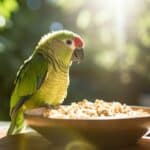As a responsible kakariki owner, you may wonder about your feathered friend’s dietary needs. A balanced diet is crucial to keeping your pet healthy and happy, and understanding what foods are safe and nutritious is essential. This article will explore whether kakarikis can eat lettuce and provide insights into their overall diet and nutritional requirements.
Can Kakarikis eat lettuce? Yes, they can consume lettuce in small amounts. However, it’s important to introduce a variety of vegetables to their diet for optimal health and nutrition.
Kakarikis are naturally omnivorous, consuming both plant and animal matter. In their native habitat, they rely on a diverse diet of fruits, seeds, and vegetation to meet their nutritional needs.
It’s important to replicate this varied diet in captivity to ensure your bird receives all the necessary essential vitamins, minerals, and nutrients. A lack of proper nutrition can lead to serious health issues, including weight loss, weakened immune systems, and even premature death.
Keep reading to discover the safe foods for kakarikis and learn how to maintain a healthy and balanced diet for your feathered friend.
Key Takeaways
- A balanced diet is essential for the health and well-being of kakarikis.
- Kakarikis are naturally omnivorous, consuming both plant and animal matter
- Replicating their natural diet in captivity is crucial to meeting their nutritional requirements
- A lack of proper nutrition can lead to serious health issues
Understanding the Kakariki Diet
Kakarikis are native to New Zealand and have a varied diet in the wild, consisting of fruits, seeds, and vegetation. Understanding their natural diet can help us make informed decisions regarding their nutritional needs in captivity.
Fruits are essential to a kakariki’s diet and can provide essential vitamins and nutrients. Some recommended fruits for kakarikis include apples, kiwis, oranges, and berries. It is important to note that fruits should be given in moderation as they can be high in sugar.
Seeds and nuts are also a staple food for kakarikis. They provide a good source of protein and fat. Suitable options include sunflower seeds, millet, and almonds.
In the wild, kakarikis consume a variety of vegetation such as leaves, flowers, and bark. In captivity, it is important to provide them with plenty of fresh greens to maintain a balanced diet. Suitable options include spinach, kale, and dandelion greens.
A well-balanced diet for kakarikis should consist of 70% pellets, 20% fresh fruits and vegetables, and 10% seeds and nuts. It is important to avoid giving your kakariki foods that are high in fat and sugar, as they can cause health problems over time.
The Nutritional Needs of Kakarikis
It’s important to ensure that your kakariki gets all the essential vitamins, minerals, and nutrients it needs. A balanced diet is crucial to their overall health and well-being. Here are some key nutritional needs of kakarikis to keep in mind:
| Nutrient | Importance | Sources |
|---|---|---|
| Protein: | Required for growth and repair of tissues | Pellets, seeds, nuts |
| Carbohydrates: | Provide energy for daily activities | Grains, fruits, vegetables |
| Fat: | Essential for proper organ function | Nuts, seeds, avocados |
| Vitamins: | Support various bodily functions | Leafy greens, carrots, peppers |
| Minerals: | Regulate bodily processes and maintain strong bones | Cuttlebone, oyster shell, spinach |
It’s also important to note that kakarikis always require fresh water. Ensure to provide clean water daily, and replace it immediately if it becomes dirty or contaminated.
Safe Foods for Kakarikis
Kakarikis require a balanced diet that includes a variety of foods to ensure they receive the necessary vitamins and minerals for good health. Here are some safe foods that Kakarikis can enjoy:
| Food | Nutritional Benefits |
|---|---|
| Fruits: apples, bananas, berries, melons, mangos, and papayas | Rich in vitamins and antioxidants that boost the immune system and prevent disease. |
| Vegetables: broccoli, carrots, peas, sweet potatoes, spinach, and squash | Contain nutrients that promote healthy digestion, strong bones, and good eyesight. |
| Grains: quinoa, millet, and brown rice | Provide energy and essential minerals for overall health. |
It’s important to note that while some foods, such as grapes, are safe for other birds, they can be toxic to kakarikis. Avoid feeding your kakariki foods that contain pesticides, preservatives, or high salt or sugar levels.
Tip: Offer your kakariki a balanced diet that includes a variety of foods in moderate amounts. This way, your feathered friend will receive all the nutrients they need for good health and well-being.
Lettuce in the Kakariki Diet
For many bird owners, lettuce is a go-to vegetable due to its availability and versatility in human diets. However, it’s important to consider whether lettuce is a suitable option when it comes to feeding your kakariki.
Can kakarikis eat lettuce? Yes, they can. However, lettuce should not make up a significant portion of their diet due to its low nutritional value. Lettuce contains mostly water and few vitamins or minerals necessary for a healthy kakariki.
That being said, offering lettuce as an occasional treat can be a way to add variety to their diet and provide some hydration. It’s important to note that iceberg lettuce in particular, should be avoided due to its high water content and lack of nutritional value.
If you choose to offer lettuce to your kakariki, it’s best to introduce it gradually to avoid any digestive upset. Chop it into small pieces, mix it with their regular food, or offer it as a standalone snack.
Remember always to prioritize a balanced diet consisting of various fruits, vegetables, and protein sources to meet the nutritional needs of your feathered friend.
Lettuce as a Treat for Kakarikis
While lettuce is generally safe for kakarikis to eat, it should be offered in moderation and as a treat rather than a staple food. Lettuce has a high water content and is low in nutritional value, so it should not make up a significant part of your kakariki’s diet.
If you decide to offer lettuce to your feathered friend, it’s important to prepare it properly. Wash the lettuce thoroughly and cut it into small, bite-sized pieces. It’s also a good idea to rotate the types of lettuce you offer to provide some variety and ensure they are not consuming too much of one type.
Remember that a varied and balanced diet is key to maintaining the health and well-being of your kakariki. While lettuce can be a fun treat, it should not replace other important foods in their diet.
Other Vegetables Suitable for Kakarikis
While lettuce can be a tasty addition to your kakariki’s diet, it’s important to offer a variety of vegetables to ensure they’re getting all the necessary nutrients. Here are some other vegetables that are safe and beneficial for your feathered friend:
| Vegetable | Nutritional Benefits |
|---|---|
| Carrots | Contain vitamin A, which is important for eyesight and skin health. |
| Bell Peppers | High in vitamin C, which is essential for a healthy immune system. |
| Broccoli | Rich in vitamin K, which is necessary for proper blood clotting. |
| Cucumber | A hydrating vegetable that is also a good source of vitamin K and potassium. |
When introducing new vegetables to your kakariki’s diet, it’s important to do so gradually. Start with small amounts and observe how your bird reacts. You can slowly increase the amount over time if they show no adverse reactions.
It’s also important to properly prepare the vegetables before serving them. Wash them thoroughly and cut them into bite-sized pieces. Remove any pits, seeds, or skins that are unsafe for your bird to consume.
By offering a variety of safe vegetables as part of a balanced diet, you can help ensure your kakariki gets all the necessary nutrients for a happy and healthy life.
Meeting the Nutritional Needs of Kakarikis
When it comes to meeting the nutritional needs of your kakariki, there are a few factors to consider. First, ensuring that the foods you offer are safe and suitable for their digestive systems is important. Second, you may need to research local sources for certain foods to provide a varied and balanced diet. Here are some tips to help you meet the nutritional needs of your feathered friend:
- Provide a diverse range of fruits, vegetables, seeds, and grains.
- Choose fresh, high-quality foods and avoid anything that is spoiled or has gone bad.
- Wash fruits and vegetables thoroughly before offering them to your kakariki.
- Consult with a veterinarian or avian nutritionist if you have any concerns about their diet or nutritional needs.
It’s worth noting that some foods may be more difficult to come by in certain regions. For example, if you live in an area without easy access to fresh fruits and vegetables, you may need to find alternative sources of these foods or consider providing dietary supplements to ensure your kakariki is getting the necessary vitamins and nutrients.
Additionally, it’s important to ensure that your kakariki has access to fresh, clean water at all times. This may require daily water changes to keep the water clean and free from bacteria or other harmful substances.
By providing a balanced and varied diet, you can help ensure your kakariki stays healthy and happy for years.
Conclusion
A balanced diet is essential to keep your kakariki happy and healthy. Understanding their natural diet and nutritional needs is key to providing the best care. While lettuce can be a safe and nutritious addition to their diet, it should be introduced gradually and in moderation.
Remember to provide a variety of fruits, vegetables, and grains to ensure your kakariki receives all of the necessary vitamins, minerals, and nutrients. Be sure to avoid any foods that pose a potential health risk, and always provide fresh, clean water for your feathered friend.
By prioritising your kakariki’s diet and nutritional needs, you can help them to live a long, happy, and healthy life in the UK.
FAQ
Q: Can Kakarikis Eat Lettuce?
A: Kakarikis can eat lettuce, but it should be in moderation. Lettuce is low in nutritional value for them and can cause digestive issues if given in large quantities. It is important to offer a balanced diet that includes a variety of foods to ensure their nutritional needs are met.
Q: What is the natural diet of kakarikis?
A: In their native habitat, kakarikis consume a diet consisting of fruits, seeds, and vegetation. It is important to replicate their natural diet as closely as possible in captivity to ensure they receive the necessary nutrients.
Q: What are the nutritional needs of kakarikis?
A: Kakarikis require a balanced diet with vitamins, minerals, and nutrients to thrive. This includes a variety of fruits, vegetables, grains, and a suitable source of protein. A proper diet is crucial for their overall health and well-being.
Q: What are some safe foods for kakarikis?
A: Safe foods for kakarikis include a variety of fruits such as apples, bananas, and berries. Vegetables like carrots, broccoli, and spinach also benefit their health. Additionally, grains such as quinoa and millet can be included in their diet.
Q: Can lettuce be offered as an occasional treat for kakarikis?
A: Yes, lettuce can be offered as an occasional treat for kakarikis. However, ensure it is given in small amounts and alongside a varied diet to ensure they receive all the necessary nutrients. Remember, moderation is key.
Q: What other vegetables are suitable for kakarikis?
A: Aside from lettuce, other vegetables suitable for kakarikis include bell peppers, zucchini, and cucumber. These vegetables provide additional nutrients and variety in their diet. Remember to properly prepare and serve these vegetables to maximize their nutritional benefits.
Q: How can we meet the nutritional needs of kakarikis?
A: Providing a well-rounded diet for kakarikis is essential. Offering a variety of readily available fresh fruits, vegetables, and grains can help achieve this. Ensure their water is clean and fresh, and consider dietary supplements if needed. Regional considerations may impact the availability of certain foods, so research and consult with an avian veterinarian for guidance.



Have comments or questions about this article? Then get involved!
Spotted an error or something we have missed? Let us know